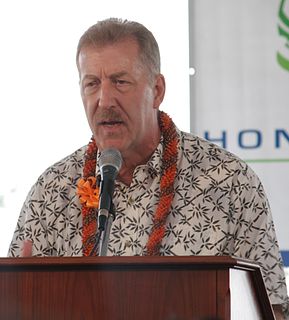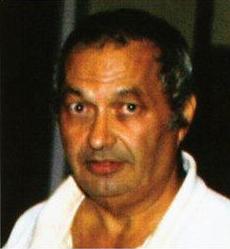Andrea Pia Yates is a former resident of Houston, Texas, who confessed to drowning her five children in their bathtub on June 20, 2001. She had been suffering for some time from severe postpartum depression, postpartum psychosis and schizophrenia. During her trial, she was represented by Houston criminal defense attorney George Parnham. Chuck Rosenthal, the district attorney in Harris County, asked for the death penalty in her 2002 trial. Her case placed the M'Naghten rules, along with the irresistible impulse test, a legal test for sanity, under close public scrutiny in the United States. She was convicted of capital murder, but the jury refused the death penalty option. She was sentenced to life in prison with the possibility of parole after 40 years. The verdict was overturned on appeal, in light of false testimony by one of the expert psychiatric witnesses.

Frank Francis Fasi was an American politician who was the longest-serving Mayor of Honolulu, Hawaii, serving for 22 years. He also served as a territorial senator and member of the Honolulu City Council.
The Honolulu Star-Bulletin was a daily newspaper based in Honolulu, Hawaii, United States. At the time publication ceased on June 6, 2010, it was the second largest daily newspaper in the state of Hawaiʻi. The Honolulu Star-Bulletin, along with a sister publication called MidWeek, was owned by Black Press of Victoria, British Columbia, Canada and administered by a council of local Hawaii investors. The daily merged with the Advertiser on June 7, 2010, to form the Honolulu Star-Advertiser, after Black Press's attempts to find a buyer fell through.

Peter Benson Carlisle is an American politician and attorney who served as the 13th Mayor of Honolulu, Hawaii from 2010 to 2013. Prior to serving as interim Mayor following the resignation of former Honolulu Mayor Mufi Hannemann, Carlisle had served as the Prosecuting Attorney of Honolulu from 1996 to 2010.

Theresa Owana Kaʻōhelelani Laʻanui was a descendant of Kalokuokamaile, the eldest brother of Kamehameha I. She was a member of the House of Laʻanui, a collateral branch of the House of Kamehameha.

Go!, based in Honolulu was a regional brand of Phoenix, Arizona-based Mesa Airlines. Go! operated inter-island services within Hawaii. Its main base was Honolulu International Airport. It was a division within the Mesa Airlines subsidiary of Mesa Air Group and its flights were operated by Mesa Airlines. The airline ceased operations in Hawaii on April 1, 2014. The company slogan was Hawaii's Low Fare Airline.

Noshir Sheriarji Gowadia is a former design engineer and convicted spy for several countries. He became one of the creators of the B-2 Spirit stealth bomber during his career at Northrop Corporation but was arrested in 2005 on espionage-related federal charges.
Halawa Correctional Facility is a state prison in the City and County of Honolulu, Hawaii on the island of Oahu. It is operated by the Hawaii Department of Public Safety. The prison is in proximity to the communities of Aiea and Halawa.
Michael Mark Welner, M.D., is an American forensic psychiatrist and Chairman of The Forensic Panel. Welner is best known for his work in sensitive and complex litigation. He has acted as lead forensic psychiatric examiner in numerous criminal or court proceedings of national and international prominence, including precedent-setting trials and higher court decisions. Welner is also known for a number of innovations in forensic science, forensic psychiatry and justice, including protocols for prospective peer review in forensic medicine consultation, research to standardize an evidence-based distinction of the worst crimes, The Depravity Standard, and recommendations for upgrading forensic science assessment. He has been featured in network television news coverage of forensic psychiatry issues, has authored publications for professional and public audiences, and has contributed to emerging legislation on mental health reform.
Kirk Matthew Lankford is an American from Kalihi, Hawaii who was convicted of murdering a Japanese tourist in Pūpūkea, Hawaii.

Samuel Pailthorpe King was an American lawyer and judge. He served as a United States District Judge of the United States District Court for the District of Hawaii.

In 2008, two attempts were made by separate groups involved in the Hawaiian sovereignty movement to occupy ʻIolani Palace, the home of the last two monarchs of the Hawaiian Kingdom in downtown Honolulu in the U.S. state of Hawaii.

Bert Takaaki Kobayashi Sr. was a Justice of the Supreme Court of Hawaii from July 17, 1969, to December 29, 1978.

The 1996 Honolulu hostage crisis occurred on February 6, 1996, in Sand Island, Honolulu, Hawaii, when 28-year-old John Miranda took hostages at the Seal Masters of Hawaii building, his former place of employment. During the hostage crisis, two hostages were injured, one seriously. Miranda was the only fatality during the crisis itself. However, a few weeks after the event, he was found to have murdered his former girlfriend prior to the crisis.

Mark Prever Robinson was a Hawaiian business magnate and politician. He served as Minister of Foreign Affairs of the Kingdom of Hawaii under the reign of Liliuokalani. During times of political upheaval and financial stress of Hawaii's changing governments, Robinson joined with other business men to come to the financial aid of the government.

The 2020 Honolulu mayoral election determined the Mayor of the City and County of Honolulu for the term commencing in January 2021. Incumbent mayor Kirk Caldwell is ineligible to run for a third term due to term limits.
David C. Schutter (1940-2005) was a Honolulu criminal defense attorney and civil litigator. He was noted for his flamboyant courtroom persona and involvement in high-profile legal cases in Hawaii during the 1970s and 1980s.
Charles Marsland (1923-2007) was a Honolulu attorney who served as the first elected Prosecuting Attorney of Honolulu from 1981 to 1988. He is best known for his aggressive prosecution of the Hawaiian Mob during the mid 1980s, which took place after the murder of his son, which was allegedly connected to organized crime.
The killing of Greg Gunn occurred on the morning of February 25, 2016, in Montgomery, Alabama. Gunn, a 58-year-old African-American man, was shot and killed near his home after fleeing from a stop-and-frisk initiated by Aaron Cody Smith, a white police officer. Smith was charged with murder and indicted by a grand jury in 2016. The case came to trial in late 2019 following a change of venue to Ozark, Alabama. Smith was found guilty of manslaughter, and, in January 2020, was sentenced to 14 years in prison.











